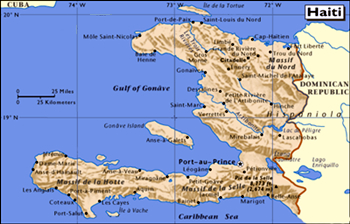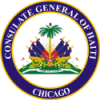About Haiti
Second largest Caribbean Island, Haiti is situated 77 km southeast of Cuba. Haiti occupies the western third of the island it shares with the Dominican Republic and has 1530 km of coast line. Mountainous land between the Atlantic Ocean in the North and the Caribbean Sea in the South, Haiti also comprises several islands surrounding the main territory: La Gonâve, la Tortue, l’Ile-à-Vache, la Navase, etc.

Nationality:
Noun: Haitian(s)
Adjective: Haitian
Ethnic groups:
black 95%, mulatto and white 5%
Languages:
French (official), Creole (official)
Religions:
Roman Catholic 80%, Protestant 16% (Baptist 10%, Pentecostal 4%, Adventist 1%, other 1%), none 1%, other 3%
Note: roughly half of the population practices voodoo
Population:
9,801,664 (July 2012 est.)
Country comparison to the world: 88
Note: estimates for this country explicitly take into account the effects of excess mortality due to AIDS; this can result in lower life expectancy, higher infant mortality, higher death rates, lower population growth rates, and changes in the distribution of population by age and sex than would otherwise be expected
Age structure:
0-14 years: 35.3% (1,732,645 male/ female 1,725,313)
15-64 years: 60.7% (2,953,603 male/ female 2,998,528)
65 years and over: 4% (174,483 male/ female 217,092) (2012 est.)
Median age:
Total: 21.6 years
Male: 21.4 years
Female: 21.9 years (2012 est.)
Population growth rate:
0.888%
Country comparison to the world: 127
Note: the preliminary 2011 numbers differ significantly from those of 2010, which were strongly influenced by the demographic effect of the January 2010 earthquake; the latest figures more closely correspond to those of 2009 (2012 est.)
Birth rate:
23.87 births/1,000 population (2012 est.)
Country comparison to the world: 68
Death rate:
8.1 deaths/1,000 population Country comparison to the world: 94
Note: the preliminary 2011 numbers differ significantly from those of 2010, which were strongly influenced by the demographic effect of the January 2010 earthquake; the latest figures more closely correspond to those of 2009 (July 2012 est.)
Net migration rate:
-6.9 migrant(s)/1,000 population (2012 est.)
Country comparison to the world: 201
Urbanization:
Urban population: 52% of total population (2010)
Rate of urbanization: 3.9% annual rate of change (2010-15 est.)
Major cities – population:
PORT-AU-PRINCE (capital) 2.143 million (2010)
Sex ratio:
At birth: 1.01 male(s)/female
Under 15 years: 1 male(s)/female
15-64 years: 0.98 male(s)/female
65 years and over: 0.8 male(s)/female
Total population: 0.98 male(s)/female (2011 est.)
Maternal mortality rate:
350 deaths/100,000 live births (2010)
Country comparison to the world: 33
Infant mortality rate:
Total: 52.44 deaths/1,000 live births
Country comparison to the world: 42
Male: 56.47 deaths/1,000 live births
Female: 48.37 deaths/1,000 live births
Note: the preliminary 2011 numbers differ significantly from those of 2010, which were strongly influenced by the demographic effect of the January 2010 earthquake; the latest figures more closely correspond to those of 2009 (2012 est.)
Life expectancy at birth:
Total population: 62.51 years
Country comparison to the world: 184
Male: 61.15 years
Female: 63.89 years
Total fertility rate:
2.98 children born/woman (2012 est.)
Country comparison to the world: 63
Health expenditures:
6% of GDP (2009)
Country comparison to the world: 105
Physicians density:
0.25 physicians/1,000 population (1998)
Hospital bed density:
1.3 beds/1,000 population (2007)
HIV/AIDS – adult prevalence rate:
1.9% (2009 est.)
Country comparison to the world: 31
HIV/AIDS – people living with HIV/AIDS:
120,000 (2009 est.)
Country comparison to the world: 37
HIV/AIDS – deaths:
7,100 (2009 est.)
Country comparison to the world: 29
Major infectious diseases:
Degree of risk: high
Food or waterborne diseases: bacterial and protozoal diarrhea, hepatitis A and B, and typhoid fever
Vectorborne diseases: dengue fever and malaria
Water contact disease: leptospirosis (2009)
Children under the age of 5 years underweight:
18.9% (2006)
Country comparison to the world: 39
Education expenditures:
NA
Literacy:
Definition: age 15 and over can read and write
Total population: 52.9%
Male: 54.8%
Female: 51.2% (2003 est.)
